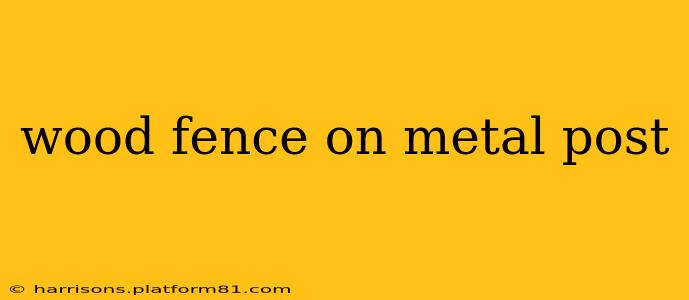Building a wood fence on metal posts offers a blend of durability and aesthetics. Metal posts provide superior strength and longevity compared to wooden counterparts, especially in challenging soil conditions or high-wind areas. This guide explores the process, benefits, and considerations involved in this popular fencing solution.
Why Choose Metal Posts for a Wood Fence?
Metal posts, typically made of steel or aluminum, offer several advantages over wooden posts:
- Increased Durability: Metal resists rot, insect infestation, and weathering far better than wood, leading to a significantly longer lifespan for your fence.
- Enhanced Strength: Metal posts are stronger and can better withstand impacts and high winds, making them ideal for areas prone to severe weather.
- Reduced Maintenance: Unlike wooden posts, metal posts require minimal maintenance, saving you time and effort in the long run. No need for regular treatments or replacements due to rot.
- Straight and True: Metal posts remain straight and plumb, contributing to a more aesthetically pleasing and structurally sound fence.
- Versatility: Metal posts are compatible with various fence styles and materials, including wood, vinyl, and composite.
What Types of Metal Posts are Available?
Several types of metal posts are suitable for wood fences:
- Steel Posts: These are the most common and durable option, offering excellent strength and longevity. They are available in various gauges (thicknesses) to suit different needs.
- Aluminum Posts: Lighter than steel, aluminum posts are more resistant to corrosion and require less maintenance. However, they might not be as strong as steel posts in high-wind areas.
- Wrought Iron Posts: These provide a more decorative look, but they are usually more expensive and require specialized installation techniques.
How to Install a Wood Fence on Metal Posts: A Step-by-Step Guide
The specific steps for installing a wood fence on metal posts will depend on your chosen fence design and the type of metal post used. However, the general process involves these key stages:
- Planning and Design: Determine the fence's location, length, and height. Consider local building codes and regulations.
- Post Hole Digging: Use a post hole digger to excavate holes deep enough to adequately support the posts – generally at least one-third of the post's height. The depth also depends on the soil type and local climate.
- Post Setting: Place the metal posts in the holes, ensuring they are plumb (perfectly vertical) using a level. Add gravel or concrete to secure the posts in place. Allow the concrete to fully cure before proceeding.
- Attaching Rails: Once the posts are set and the concrete has cured, attach horizontal rails to the posts using appropriate fasteners. This forms the framework for the fence panels.
- Installing Fence Panels: Attach the pre-built fence panels or individual fence boards to the rails. Make sure the panels are aligned and securely fastened.
- Finishing Touches: Add any necessary finishing touches, such as caps for the posts, to enhance the aesthetics and protect the metal from the elements.
What are the Costs Involved in Building a Wood Fence on Metal Posts?
The cost of a wood fence on metal posts varies depending on several factors:
- Fence Length and Height: Longer and taller fences naturally cost more.
- Type of Metal Post: Steel posts are generally less expensive than aluminum or wrought iron.
- Type of Wood: The cost of wood varies depending on the species and grade.
- Labor Costs: Hiring a professional to install the fence will significantly increase the overall cost.
How Long Does a Wood Fence on Metal Posts Last?
With proper installation and maintenance, a wood fence on metal posts can last for 20-30 years or even longer. The lifespan of the wood itself will be a determining factor here, as the metal posts should last considerably longer. Regular inspections and prompt repairs will also help extend its lifespan.
What are the Alternatives to Using Metal Posts for a Wood Fence?
While metal posts are a popular choice, you can also use wooden posts. However, be aware that wooden posts require more maintenance and have a shorter lifespan. Other alternatives include concrete posts or composite posts.
How Do I Choose the Right Size Metal Post for My Fence?
The size of the metal post you need will depend on several factors, including the height of your fence, the soil conditions, and the expected wind loads. It's always best to consult local building codes and a fencing professional to determine the appropriate post size.
This comprehensive guide provides a solid foundation for understanding and building a wood fence on metal posts. Remember to consult local building codes and consider seeking professional help for larger projects or challenging installations. The longevity and strength of metal posts contribute to a long-lasting and beautiful fence that will enhance your property for years to come.
